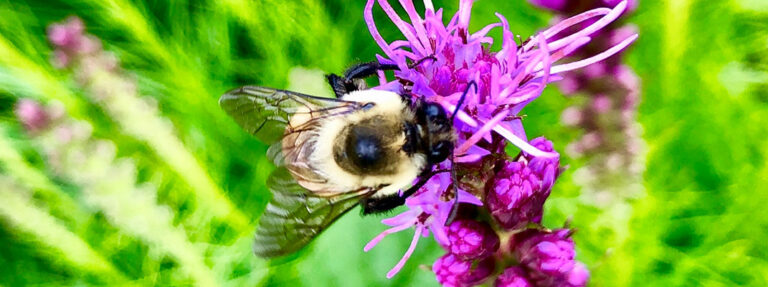Bumblebees are more than just adorable garden visitors. Underneath the cute and fuzzy exterior lies an essential pollinator that helps sustain ecosystems, support food production, and maintain plant diversity. Yet across the Northeast and beyond, their numbers are falling fast. For landowners, growers, and conservation-minded citizens, understanding this crisis is the first step toward reversing it.
In this guide, you’ll learn:
- Which bumblebee species are most at risk
- What these pollinators need to survive and thrive
- How to make your land more bee-friendly, whether rural or urban
- Practical conservation strategies tailored to your environment
Bumblebee conservation doesn’t require perfection, but it does require action. That starts with understanding the challenges they face.
Understanding Bumblebee Declines
For years, biologists and ecologists have been sounding the alarm bells: bumblebee populations are in decline. It’s no secret, but the factors contributing to this decline are not well understood by the general public. For farmers, landscape architects, and even gardeners, understanding the underlying causes is the first step towards rebuilding the bumblebee populations.
Species in Trouble
Though many bumblebee populations are declining, we’ve identified several species that are facing the biggest threats:
- Rusty Patched Bumblebee (Bombus affinis): Once common throughout the Midwest and eastern United States, this species has experienced an estimated range retraction of 87% in recent years.
- American Bumblebee (Bombus pensylvanicus): Despite being extremely important to America’s farmland, American bumblebees have declined by nearly 90% relative to other bee species in the same habitat.
- Yellow-banded Bumblebee (Bombus terricola): These bees were also common in the northeast, but now are only found in higher elevations, while their range has shrunk by 31%.
Identifying the bumblebee species being hit hardest is a great start, but the question remains: What is causing the declining populations of these bumblebees?
The Leading Causes of Bumblebee Decline
The leading causes of bumblebee decline are habitat loss/fragmentation, pesticide exposure, pathogens, and climate change.
Habitat Loss and Fragmentation
When native grasslands, meadows, and forests are replaced by monocultures or urban development, bumblebees lose both food sources and nesting sites. Even when patches of habitat remain, they’re often too small or isolated to support sustainable populations.
Pesticide Exposure
Neonicotinoids and other systemic pesticides have been shown to impair bumblebee navigation, suppress immune systems, and reduce reproductive success. Even small doses picked up from treated plants can have long-term effects on colonies.
Pathogens and Disease Spillover
Pathogens like Crithidia bombi, often introduced through commercial bee operations, spread quickly among wild bumblebee populations. Infection weakens bees, shortens their lifespans, and lowers colony survival rates.
Climate Change
Shifts in seasonal temperatures are causing flowers to bloom earlier or later than normal, leading to mismatches between peak floral availability and bumblebee foraging needs. Rising temperatures can also push species like Bombus terricola into smaller, cooler refuges.
What actions can we take to help bumblebees?
What Bumblebees Need: An Increase in Habitat
Avoiding harm in the form of pesticides and habitat destruction is a great start, but if you want to actively contribute to the resurgence of bumblebees, you’ll need to know more about their habitat needs. Fortunately, creating a bumblebee-friendly environment is practical, scalable, and rewarding for both pollinators and the broader landscape.
Key Ingredients for Bumblebee Health
While bumblebees are resilient by nature, they rely on a few critical resources to survive and reproduce. Providing these on your farm, garden, or property can make a measurable difference.
- Continuity of bloom from as early to as late in the growing season as possible.
- At least three species in bloom in the late spring/early summer, summer, and fall.
- At least five plant families.
- Host plants for specialist bumblebees.
- If possible, 26 plant species.
A landscape with these floral resources you will have continuity of nectar supply and a diverse supply of pollen. Nectar provides adult bumblebees with the carbohydrates they need for daily energy. Without reliable nectar, foraging trips are cut short, and colony productivity plummets. Pollen delivers vital proteins, fats, and micronutrients necessary for larval development. A lack of pollen diversity can starve growing colonies.
Rebuilding Bumblebee Nesting
Food is only part of the story. Nesting and overwintering sites are just as crucial for population success.
Many bumblebee species nest underground, often in abandoned rodent burrows, clumps of grass, or soil cavities. Maintaining undisturbed areas of native vegetation can give them the shelter they need.
Other species seek shelter in brush piles, hollow logs, or grassy hummocks. Depending on the species in your locale, allowing a bit of natural “messiness” on your land can create valuable habitat for them.
Regardless, nests must be protected from regular tillage, flooding, and overheating. Once you spot signs of a nest, minimizing disruption around the area can help colonies successfully complete their life cycle.
Matching Knowledge to Context: Bumblebee Conservation in the Real World
What are some steps you can take to conserve and increase bumblebee populations in a way that fits your landscape, goals, and daily operations? Knowing what bumblebees need is only the beginning.
Conservation Strategies by Landscape
Whether you manage acres of farmland or a small city garden, targeted actions can make a significant impact.
- Farms: Farmland that integrates native hedgerows, cover crops, and field borders are more hospitable to bumblebees. Reducing tillage and allowing parts of your land to stay uncultivated can also create vital nesting and foraging areas.
- Gardens: Consider adding native plants or swapping native plants for exotic ornamentals in your landscape. Allow parts of your yard to grow a little wild and avoid using synthetic mulches that ground nesting bumblebees cannot penetrate.
- Urban Areas: Use containers, rooftop gardens, and pocket parks to introduce more flowering plants into developed spaces. Vertical gardens can also support pollinators where ground space is limited.
No matter the size or setting of your land, creating pockets of diverse, native habitat is one of the most effective ways you can actively support bumblebee recovery.
Rethink Maintenance Practices
Many traditional landscaping habits can unintentionally harm bumblebee populations. Frequent mowing, aggressive cleanup, and heavy pesticide use strip away the very resources bees depend on. Instead:
- Delay mowing until after wildflowers have finished blooming.
- Leave dead stems, leaf litter, and brush piles over the winter to support overwintering queens.
- Adopt Integrated Pest Management (IPM) strategies to minimize chemical use and target applications more carefully.
By adapting your practices to fit local conditions and seasonal cycles, you can turn almost any space into a refuge for bumblebees, as well as countless other pollinators.
Taking Action: Join Ernst Seeds in the Fight for Bumblebee Conservation
Throughout this guide, we’ve explored why bumblebees are so vital to ecosystems and agriculture, which species are most at risk, what resources bumblebees need to thrive, and how practical land management strategies can make a real difference. Whether you manage farmland, a garden, or an urban space, your actions have the power to create meaningful change.
For ready-made solutions, Ernst Conservation Seeds offers a wide selection of regionally adapted native seed mixes designed to support pollinators, including bumblebees.
Take the next step in building a healthier future for bumblebees and the ecosystems they sustain. Contact our experts or explore our catalog to find the right seed mix for your landscape.

